Sign up for daily news updates from CleanTechnica on email. Or follow us on Google News!
Under the auspices of the India Smart Grid Forum, the think tank founded as an umbrella organization over India’s 28 state utilities to provide thought leadership, share leading practices, and bring international insights to India, I’m delivering bi-weekly webinars framed by the Short List of Climate Actions That Will Work. With the glories of online recordings and AI transcription tools, it’s relatively easy to share both the transcript, and also the slides that I used, so I’m making a habit of it.
Most recently, I delivered a talk and held a Q&A session on the theme of Electrify Everything Everywhere All At Once. For those who prefer talk-talk to read-read, here’s the recorded video of the presentation and discussion.
Thank you Reji. Thank you to the India Smart Grid Forum for inviting me to assist India in my tiny way to thread this need of decarbonization and growing your economy. It’s a great privilege. The presentation I’m going to do is a deep dive into one of the segments of the material that I presented at the India Smart Utilities Week. Unfortunately, I ended up at the very end of the day competing with appetizers and cocktails, so I suspect the room was a little less full than it is today. Without further ado, let’s start moving into it. This is the Short List. Reji, I believe that there is a video of that presentation available from ISGF.
I encourage people to go and review that, but it’s also available on Forbes as the Short List of Climate Actions That Will Work. But today we’re going to talk about electrify everything.
Over the next six months or so, every couple of weeks, we’re going to do another webinar and discuss each of these points. We’ll explore them in context of India. Please ask tough and challenging questions. The value I’ll get from this with tough questions is immense.
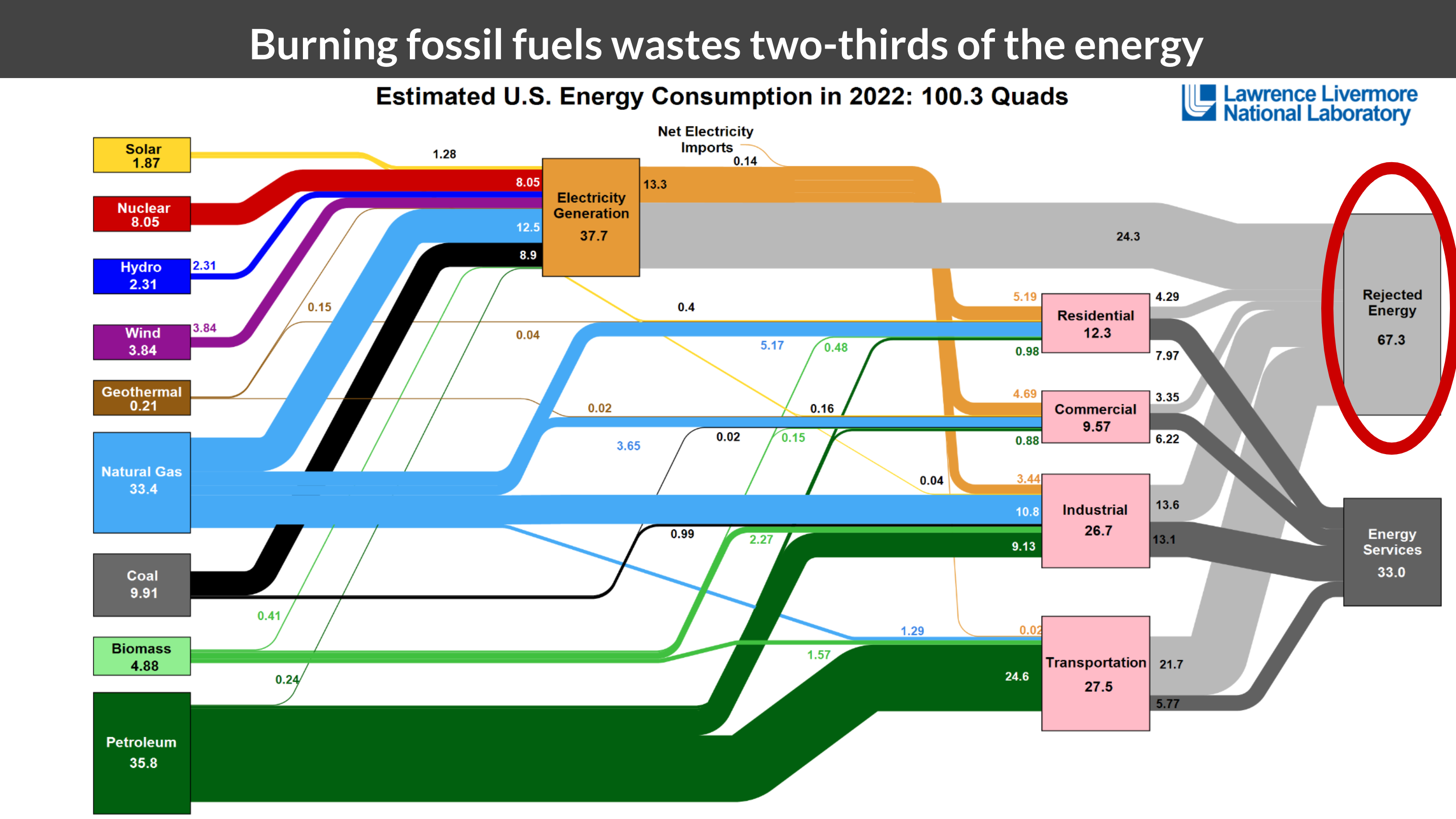
As I did in that presentation, I apologize for not using India’s energy flow diagrams, but instead using the United States energy flow diagram.
The reason for that is very simple. The US energy flow diagrams, while still imperfect, have the most clear visualization of the amount of energy we waste in our economies. Roughly two-thirds of all the energy which comes in on the left goes into waste heat entropy on the right instead of to actually useful energy services. This is almost entirely energy waste heat from burning fossil fuels.
If we consider a pathway, for example from wind energy into electrical generation, there’s virtually no rejected energy from that pathway. As we consider the pathway of those going into residential lighting and heating, there’s virtually no loss of energy through that.
Most wind energy and solar energy goes directly into energy services, things which drive our economies forward and give us greater comfort and greater affluence.
By contrast, let’s consider petroleum. As it comes through into transportation, 80% of the energy in petroleum goes into rejected energy. Very little goes into useful energy services. This gives India a tremendous opportunity as a developing country.
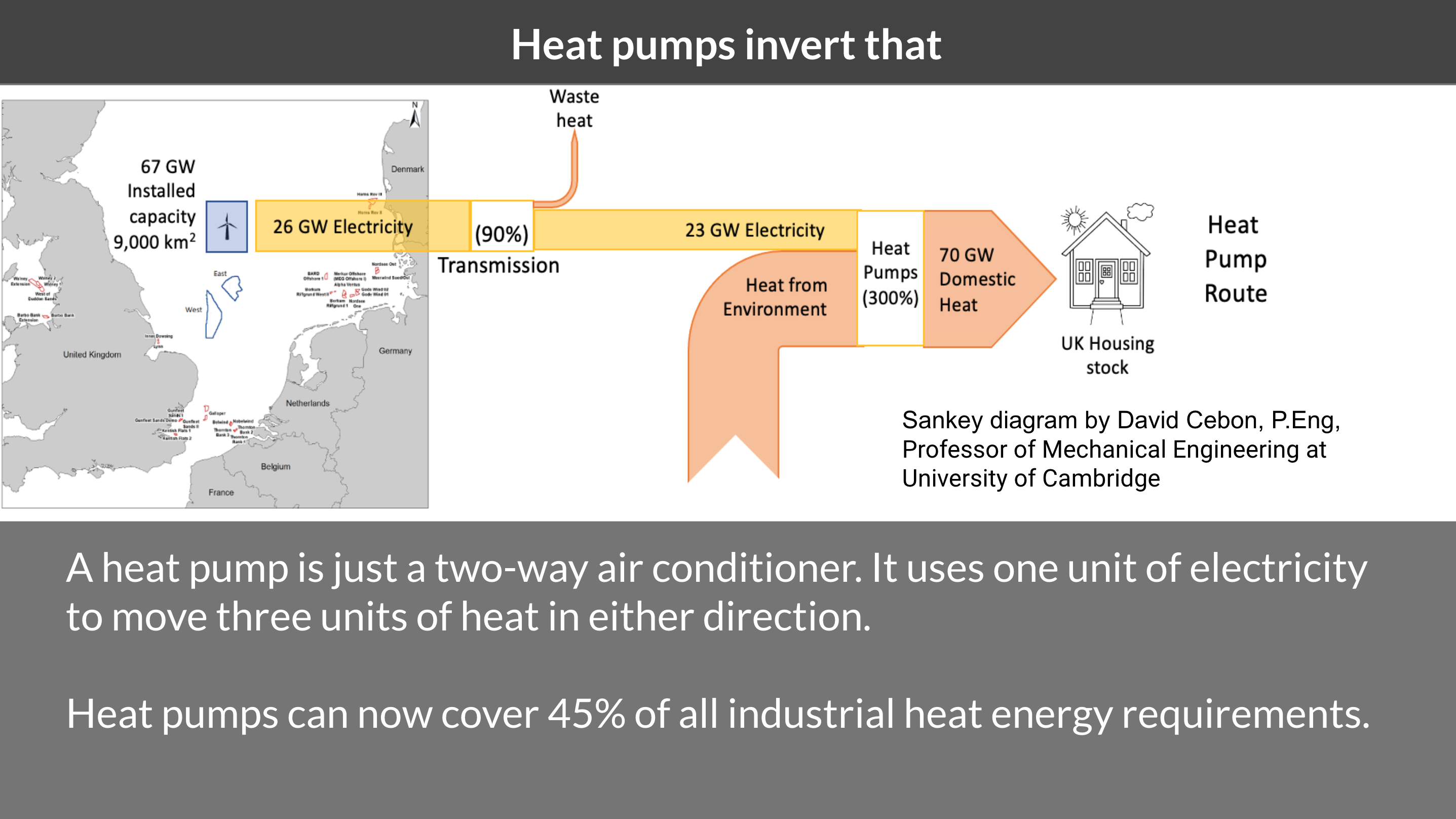
Let’s take a couple of examples. This is material created by Dr David Cebon, a mechanical engineer in Cambridge and founder of the International Centre for Sustainable Road Freight. He’s a founding member of the Hydrogen Science Coalition, which was formed to bring sanity to some of these discussions.
As you can see, one of the clear technological advantages for especially colder climates and the colder parts of India is that you get a bunch of heat from the environment, or in the case of air conditioning, cold from the environment and move it into where it is needed. You need one unit of electricity to get three units of heat.
That sounds great for home and residential heating. But it’s especially important in India’s context for industrial heating. 45% of all industrial heat energy requirements are below 200° Celsius. We now have heat pump technology, as well as heat recovery technologies and heat storage technologies, that allow us to provide 200° Celsius heat and steam for industrial processes, for food processing material, and the like. This gives us a tremendous opportunity to electrify and leapfrog and reduce our expectations about burning fossil fuels in order to achieve our industrial and food requirements.
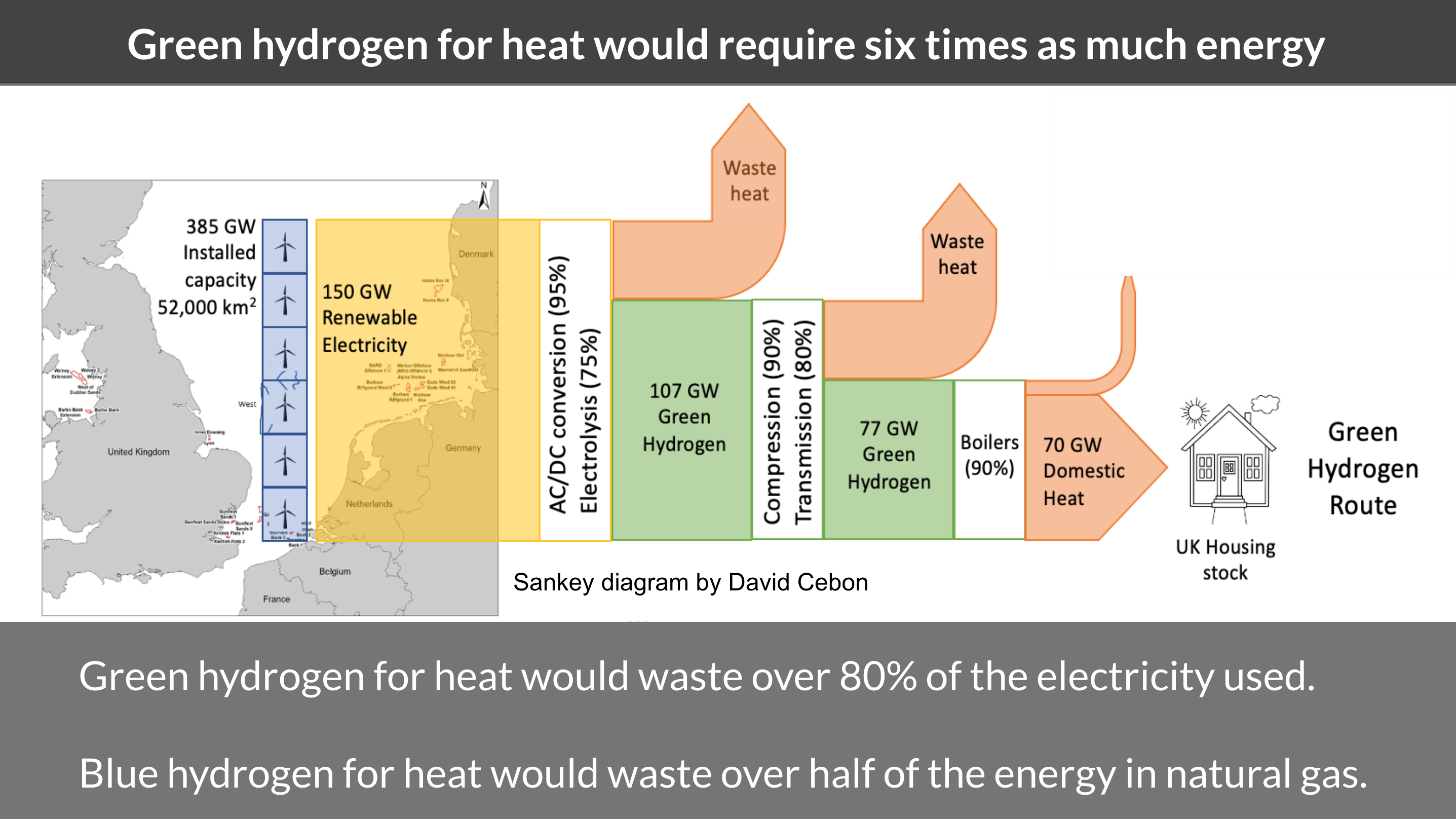
A theme through this set of presentations is hydrogen for energy being inappropriate. Hydrogen is such a hyped technology right now, and it’s hyped in India as well. I know there’s been a bunch of announcements in the past few months about hydrogen as an energy pathway.
In India, the same energy pathway would require six times as many renewables to generate electricity, to generate green hydrogen, to transport green hydrogen, to burn green hydrogen to achieve the same heat value outcomes.
Hydrogen as an energy carrier, as opposed to electricity, is six times less efficient. Hydrogen, back to that rejected energy concept, would increase rejected energy in our society. That means you would have to build a lot more generation in order to use green hydrogen for energy purposes.
This doesn’t mean green hydrogen isn’t absolutely necessary for decarbonizing the things that it’s required for, such as ammonia fertilizers, but it does mean that we should be very leery about considering it for any energy pathway.
Similarly, blue hydrogen for heat, taking natural gas or coal gas and doing carbon capture, well, the carbon in the methane is 45% of the energy content of that fossil fuel, so we’re throwing away 45% of the energy, and then we’re using energy to do that. We’re throwing away half the energy in an already high waste fossil fuel pathway.
Once again, we’re doubling rejected energy. This isn’t an efficient or effective way to run our society if we have alternatives.
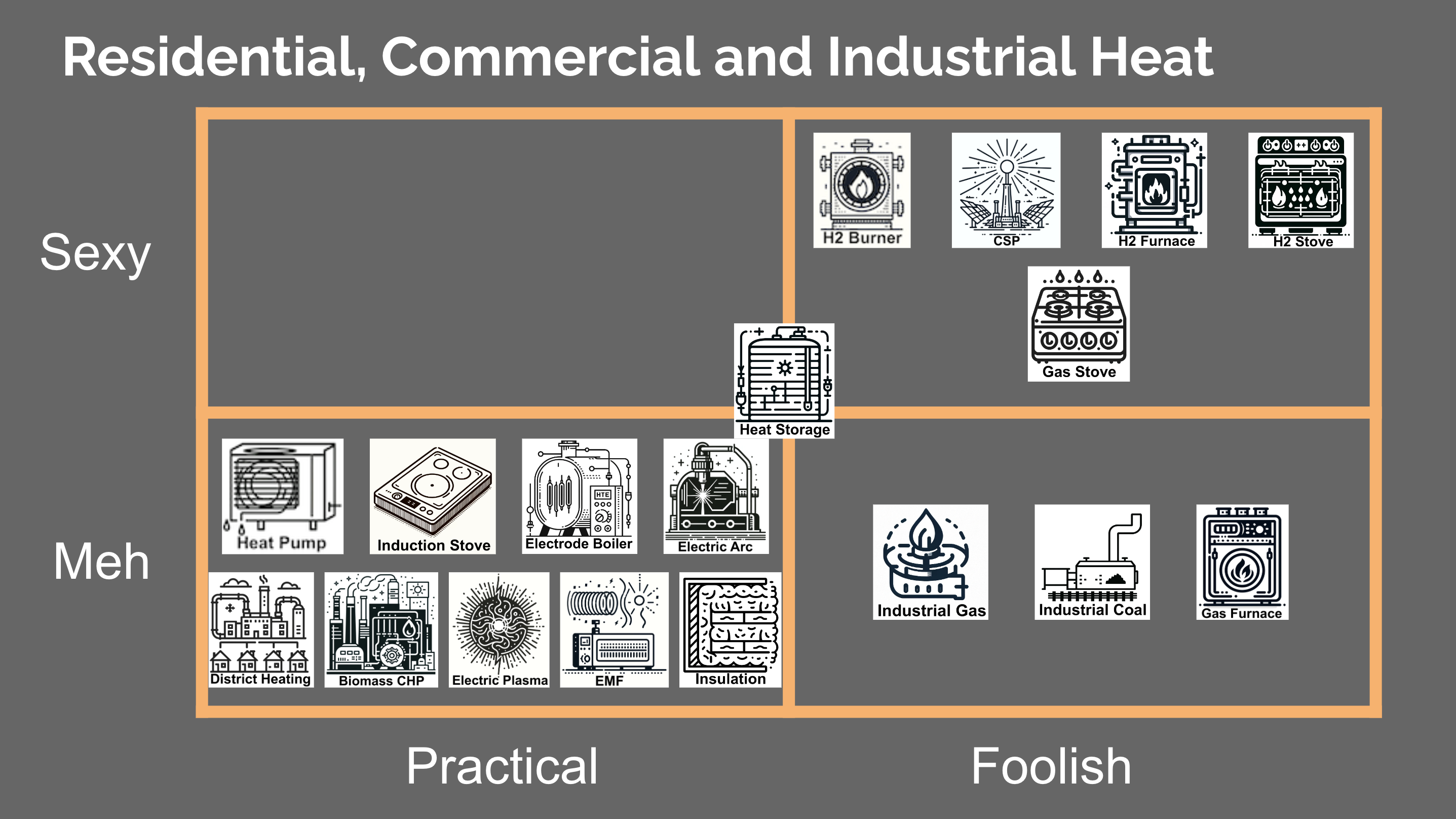
In context of all the heating options, one of the forms I created a couple of years ago to help start exploring some of these ideas was a quadrant chart. The chart had four quadrants. It had a sexy versus meh, the meh being kind of boring, but maybe it works, maybe it doesn’t. The practical versus foolish, and the stuff that makes sense is in the practical column. The stuff that doesn’t make sense as we move forward is in the foolish column.
There’s a lot of hype, there’s a lot of attention paid to the stuff in the sexy row. Generally speaking, there isn’t nearly as much hype or enthusiasm for this stuff in the bottom row. Ss we look at this, there’s a lot of stuff like concentrating solar power, which looks really attractive and decorates a lot of articles, but doesn’t really work compared to photovoltaics. A lot of discussion of hydrogen for heating and hydrogen for industrial heat.
As I pointed out, the rejected energy of using green hydrogen or blue hydrogen for industrial or domestic heating is extraordinary. One of the things that worked out really well globally, as it turns out, is “cooking with gas.” It was an advertising jingle. Now people are using induction stoves and they’re much more efficient and much better for indoor health.
As we get down to the bottom row, there’s foolish stuff that we have to persist for as little time as possible. This is the use of industrial coal and gas for furnaces and industrial gas burners. Those things are currently kind of boring, staid use cases. They’re all significant portions of greenhouse gas emissions as well as air pollution. Once again, they’re less efficient than the electrified alternatives.
Let’s get over into the boring stuff. Heat pumps, induction stoves, and you see just the sheer number of different technologies here, including plain old boring insulation, these are indicative of the sheer variety of electrified heat solutions that we have. There is almost no area of heating requirements that cannot be met with electrification. It is a matter of delivering enough electricity, in some cases in the right way.
The electric arc furnace is interesting for India, because India is currently the second biggest manufacturer of steel in the world, after China — about a 10th of China’s output as of 2022. Electric arc furnaces are a key part of the decarbonization strategy for steel, because they can take new iron products, like ones made with hydrogen or electrolysis from iron ore, and then make new steel, or they can take scrap steel and make new steel.
My projections of the future of steel manufacturing will be at about 75% of supply of steel coming from scrap steel, some of them from the almost 1000 ultra large crude carriers still plying our oceans, and much of it from the fossil fuel infrastructure, and only 25% new steel. Electric arc furnaces become very important.
Electric plasmas are very interesting, but we have all the solutions we need. District heating and cooling systems are key, and I know that India has a lot of those.
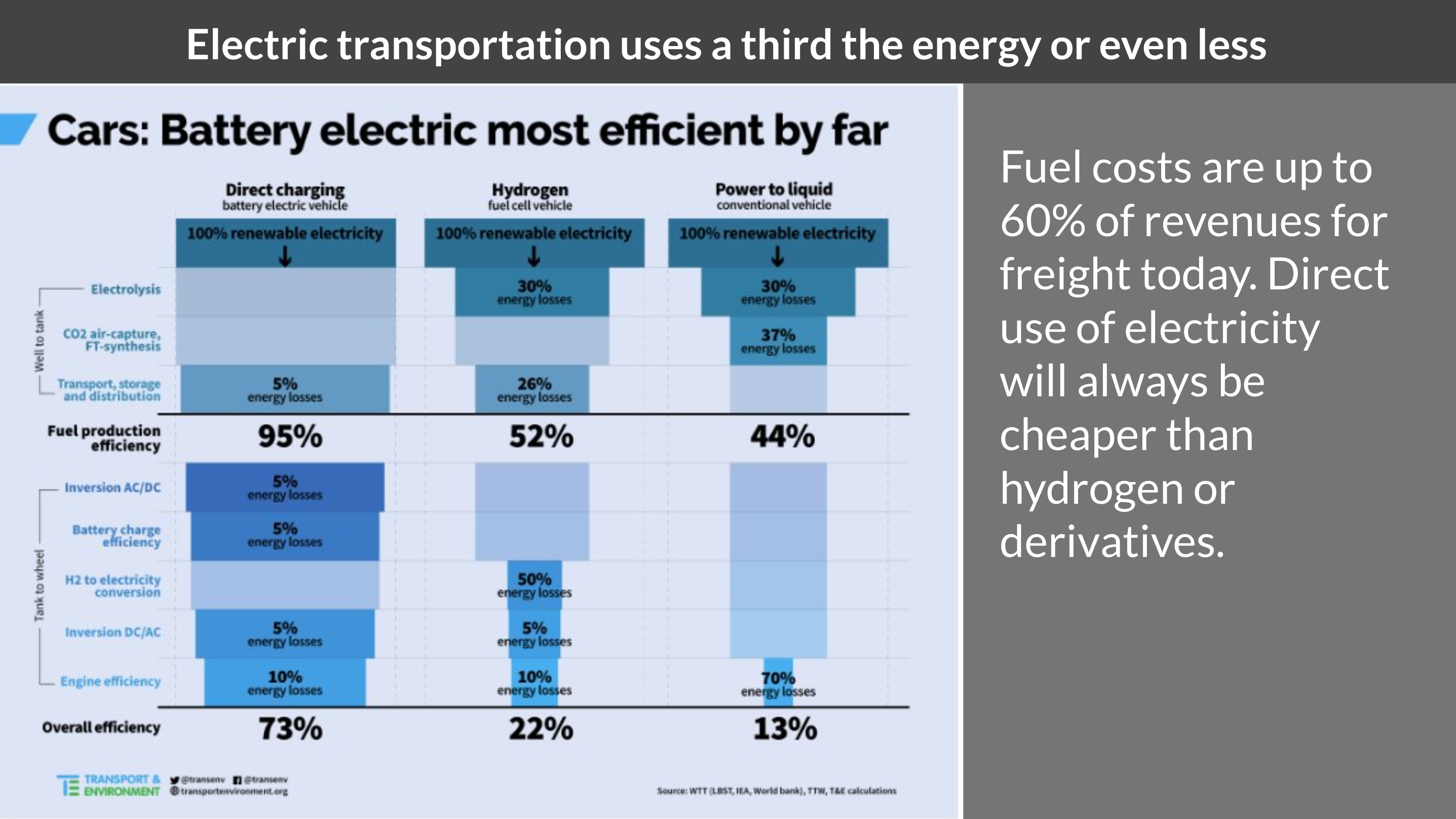
When we look at transportation, that big petroleum waster, we have tremendous efficiency gains. This is by Transport & Environment, a European organization. It’s an infographic provided to give context. What I’ve seen of India is that certainly you’re still exploring hydrogen for transportation. You’ve bought some small hydrogen locomotives for some legacy tourist routes in scenic parts of India. At least in rail, India is going exactly the right direction. You’re electrifying, you’re approaching 100% electrification. I’ll get a bit more into that later. What a great global leader you guys are.
Power-to-liquid is an interesting one to bring out as well. Once again, power-to-liquid makes green hydrogen with electricity, gets carbon dioxide from somewhere, puts them together in a common industrial process like Haber-Bosch for ammonia, and then distributes and put them in engines.
Once again, 13% efficient at turning electricity into forward motion. A power-to-liquid solution once again increases rejected energy. In a society maximizing and multiplying the amount of renewable electricity you have to manufacture, any pathway that goes from electricity to an end electric use case as efficiently as possible will always be cheaper operationally and from a maintenance perspective.

Here’s another sexy versus meh chart. There’s some fun stuff in here.
Up here in the upper right hand corner, there’s silly things like maglev trains. We’ve probably all read about them, but there’s only 60 kilometers of operational magnetic levitation trains in operation after 70 years.
Hydrogen cars are literally falling off the market. The numbers are plummeting because it doesn’t make any sense there. Elon Musk’s Hyperloop is a complete and utter distraction. E-fuels, once again back to that Transport & Environment infographic, are only 13% efficient at turning green electricity into forward movement.
There are weird EVs like the Aptera. India is one of the few places where three-wheeled electric road vehicles make sense, and some of that is legacy regulation related to a specific province in India, but some of it is just because you evolved and developed differently. But in North America and Europe, weird three-wheeled EVs have a legacy of failure. Hydrogen trains, hydrogen trucks are in this quadrant as well.
Interestingly, down here in the foolish but meh quadrant, pipelines are going away, and biofuels, while essential for aviation and road transportation, are going to go away for ground transportation. All ground transportation will be electrified.
In a world where we are running everything on electrons and getting those electrons to the end ground vehicles as efficiently as possible and putting them into increasingly cheap batteries as Reji pointed out, what is the purpose and value of a pipeline? We’re not going to be distributing gas.
One of the interesting things is that, finally, even Germany is recognizing this. Just in the past month, they’ve acknowledged that gas distribution pipelines to all homes and businesses will not be necessary in the future. There will be no large gas distribution grid. They’ve started planning for the intelligent, strategic sunsetting of their gas grid. That’s going to take a sub-isolation network by sub-isolation network approach, with likely a decade or 15 years of shutting it down. This is an interesting place where India is rapidly expanding its gas distribution grid.
It’s one of those challenging points because the gas that is delivered produces necessary heat, but it provides heat that isn’t burning biomass, that isn’t charcoal, that isn’t coal. It’s cooking food, it’s providing sterilization heat in hospitals. That has value. But as much as you can electrify instead of using gas as rapidly as possible, the better off you’ll be systemically, because you’ll be having to decommission a lot fewer pipelines in the future. Right now, I’d assert the gas grid in India is expanding inappropriately rapidly compared to electrifying more things.
But over here in the sexy and practical quadrant we have high speed rail, very sexy, very practical electric cars and electric trucks.
Down here in the meh but practical quadrant we have grid-tied trains. As I said, India is getting to the 100% point on rail electrification. Battery trains are now seeing significant increases in range because it’s mostly like shipping, where the cost of batteries matters more than the mass or volume. There’s lots of room on trains for batteries and the rolling resistance is low. The aerodynamic efficiency is high because they’re long. We’re starting to see now 100-, 200-kilometer ranges, just with batteries. That’s completely sufficient to bridge non-electrified segments of certainly passenger rail and regional passenger rail, but increasingly freight rail. Containerized batteries for trains and ships are going to be a big segment, in my perspective.
Battery trucks and battery buses, which India is doing a very good job on, are also in this quadrant. I know you have plans for 50,000 battery-electric buses by 2027. Various international partners have signed off on that. In context of that, the ISGF, as Reji has shared with me and I looked at the white paper, has done a great job of right-sizing batteries for the routes. As batteries get increasingly cheap, that will become less and less important.
Everybody in the west is attempting to achieve diesel bus range and operational characteristics instead of accepting that batteries are different. India, at least right now, is doing a much better job accepting the current limitations of batteries and working around them. Personal EVs, electric bikes, and in India’s case, electric three-wheelers are all in this quadrant.
I watched a documentary recently on the amazing penetration of electric three-wheeler taxis in India and the microeconomy of moving people and families around. Fascinating stuff to watch. That has emerged completely, as far as I can tell, without significant governmental support, just because it’s a better, cheaper way to do things.
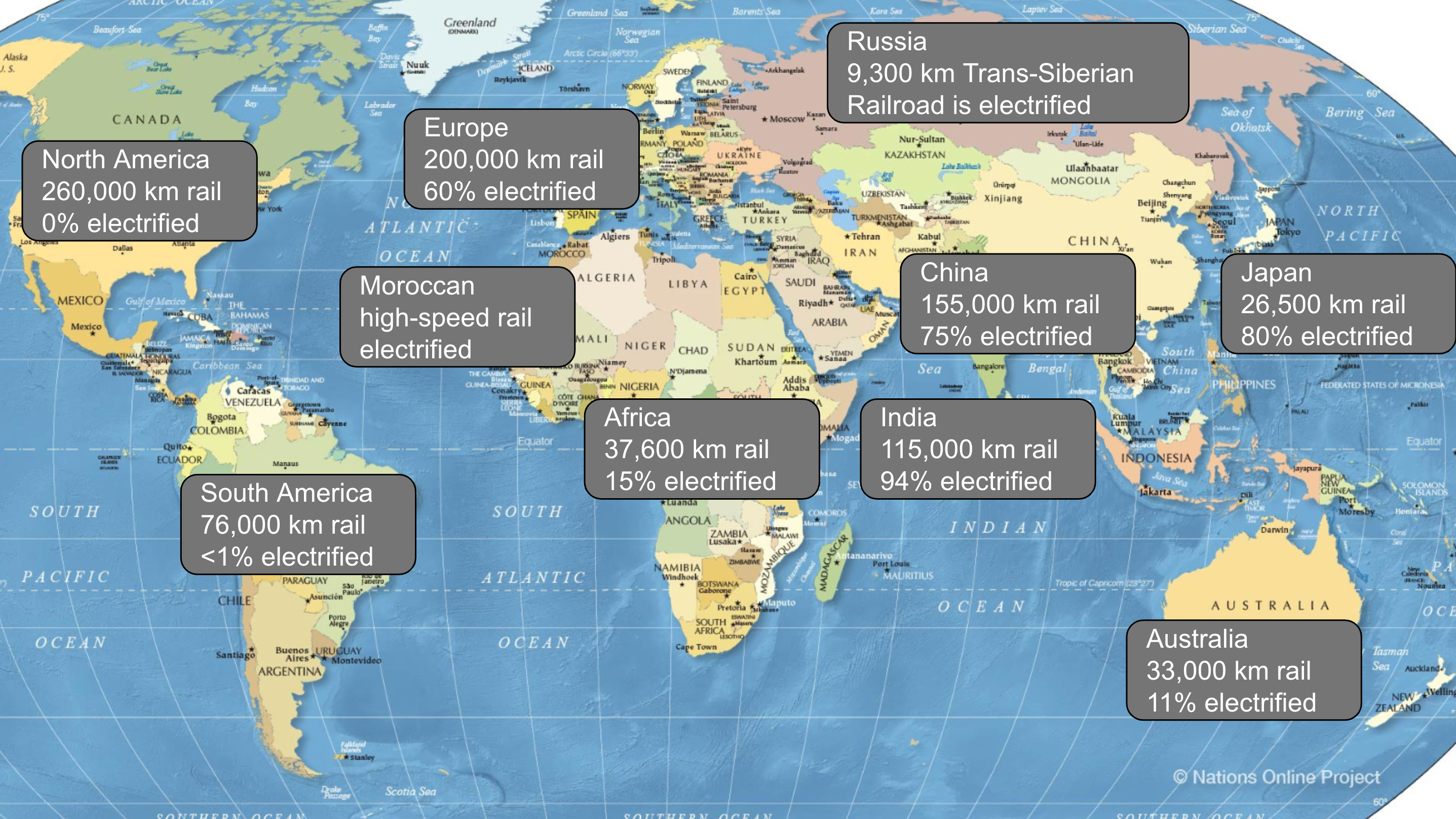
Here’s the rail situation globally. There is one outlier pair of continents, North America and South America. They just haven’t got the rail electrification memo. Meanwhile, India, as I said, is at 94% electrification as of yesterday. And is it targeting 100% this year for heavy freight rail. That’s an amazing accomplishment, and I tout that regularly. And India has shown that’s doable in a decade and a half. This is not hard to do. Africa is 15% electrified. Morocco and Indonesia both have more high speed rail than North America does, which is amazing to me.
The 9,300-kilometer Trans-Siberian Railway, which is now being used to carry freight from China to Europe, interestingly, is fully electrified. This is the obvious path forward for rail. It’s a linear asset. Electrical generation with overhead catenary lines is a linear asset. It makes complete sense, and it’s fascinating to think of the reasons why North America refuses to get the memo on this.
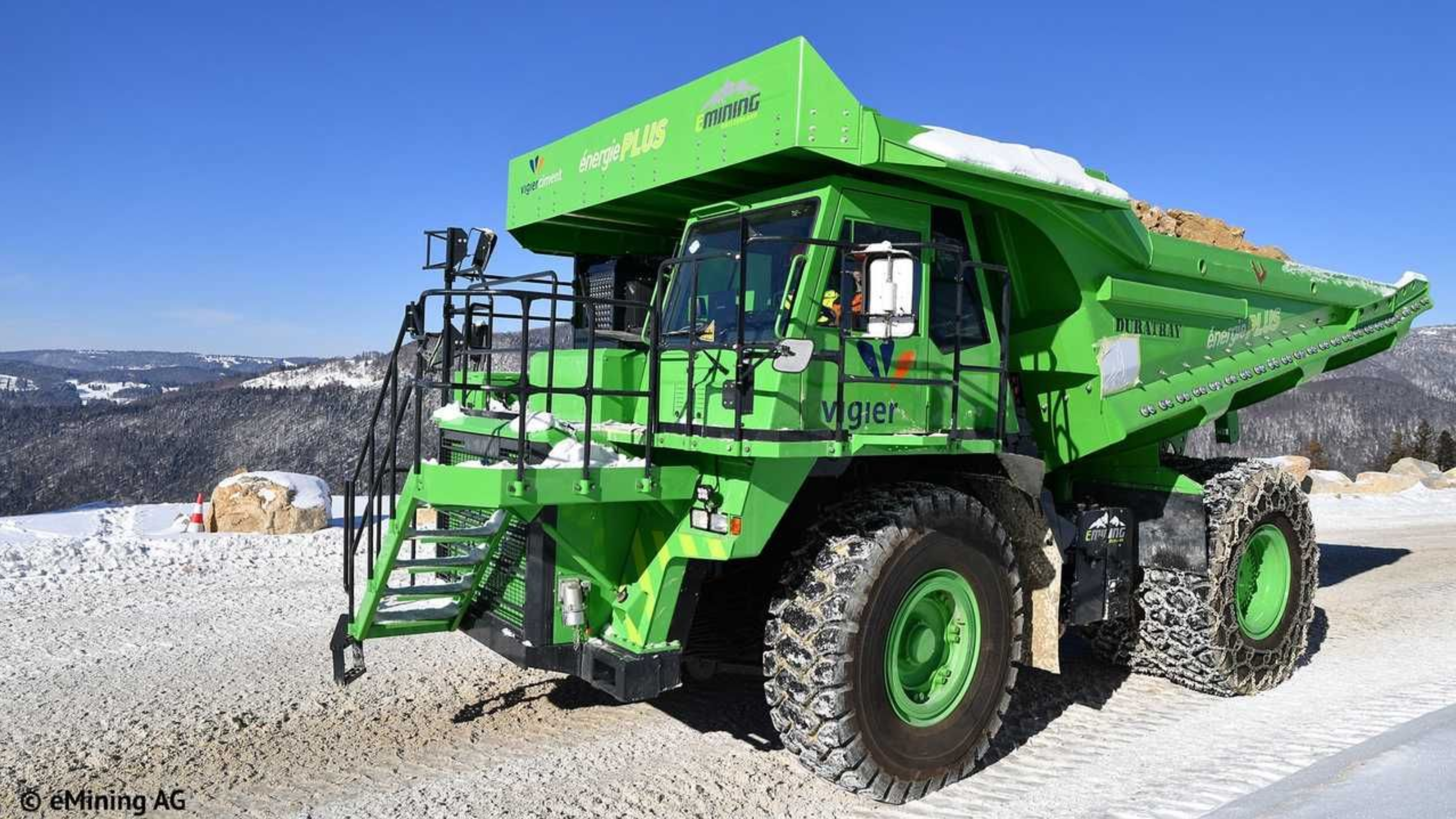
Let’s look at some of the edge conditions of electrification of ground transportation. This is one of the biggest mining trucks in the world. The ladder on the side, basically, that’s a couple of meters off the ground. Getting up the ladder itself is a bit of a hike for some people. And it’s an electric truck.
In the past year, major mining giants Rio Tinto, BHT, and Fortescue have all said, yeah, we’re going to make our mines electric, we’re going to make all of our mining vehicles electric. It’s just more efficient. Hydrogen has no play in this space. So all the edge conditions for biofuels, for synthetic fuels, for hydrogen are dropping off one by one because battery-electric and building renewables is so cheap.
In Australia, they just recently did something fascinating. They decommissioned a 6-gigawatt solar farm after six years. Why? Because they built it for a remote mine. The mine had reached end of life. So they decommissioned the solar farm and they’re moving it to another mine to provide solar power for that mine and thus reducing massively the amount of mining emissions. They are creating safer working conditions for all involved because there’s no buildup of diesel fumes underground or for drivers above ground.

Now to shipping. There’s a story here. I know Reji loves this chart. He and I have talked about it. Shipping is going to diminish, not increase. This is a heterodox projection, but it’s hard to find a reason why it wouldn’t be true because 40% of bulk shipping is of fossil fuels. Big tankers full of oil or LNG. Ships full of natural gas or bulk ships full of coal. Another 15% are full of raw iron ore going from Australia and other places that have big mines to most of the same ports the coal is going to in China and other places. India has its own massive mining facilities for that. You’re moving a lot more stuff by rail or processing it with coal locally.
That 55% of bulks is going to diminish substantially over the coming decades. We’re at peak fossil fuels this decade, and the decline is not going to be immediate, but it is going to be declining decade by decade. And coincidentally, the most egregious fossil fuels are going to be going away first, which is advantageous. Sadly, for my neighbors in Alberta in Canada with their oil sands, that’s going to be first off the market because it’s the highest sulfur, highest CO2 emissions to manufacture, and it’s the most expensive to clean up.
Container shipping will increase, but it will not increase nearly as much as bulks decrease. And so that makes for a different kind of parameter because those bulks are transoceanic in many cases.
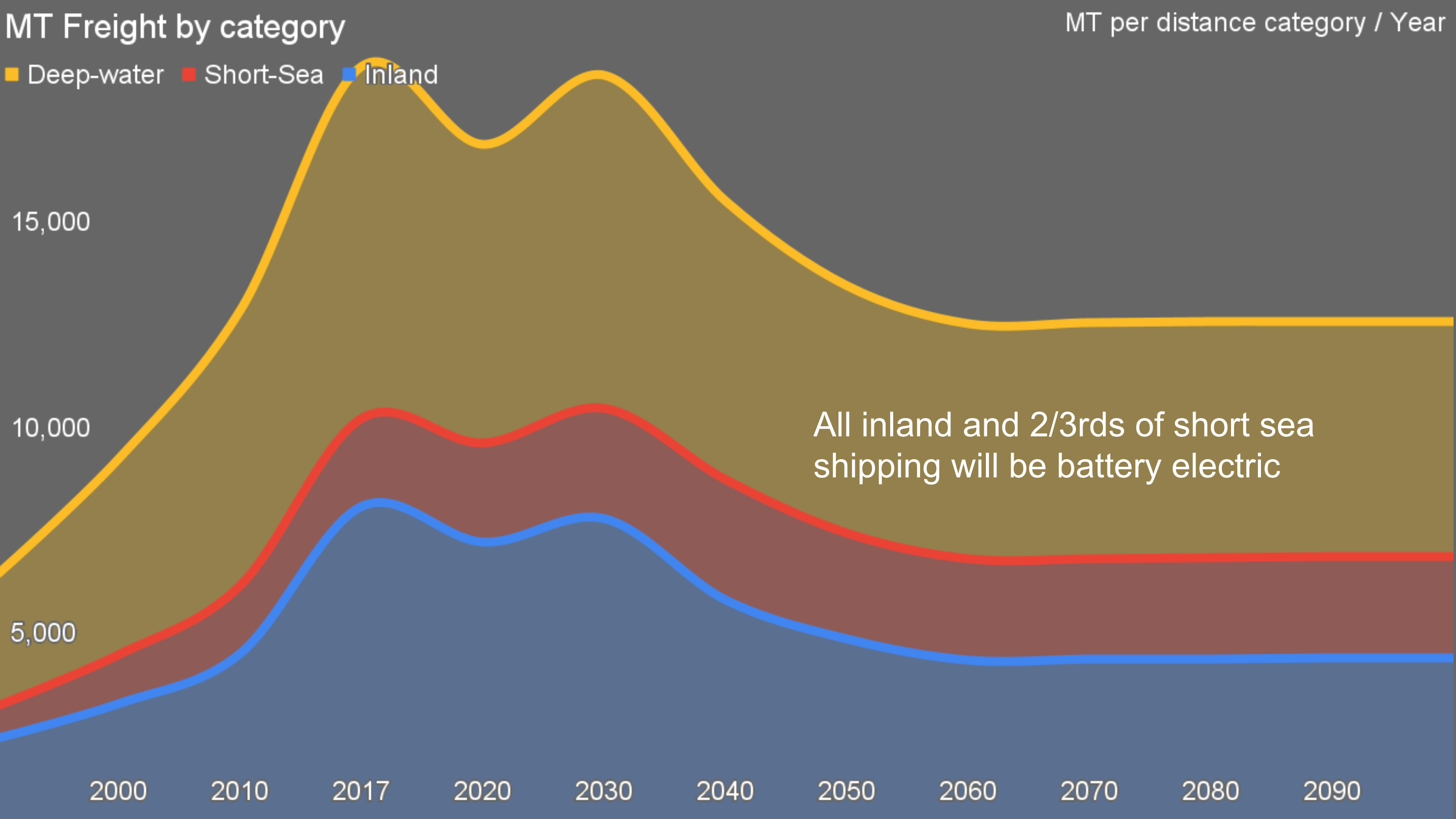
What does that mean? Well, if we think about inland, short sea, and deepwater shipping — deepwater shipping is crossing oceans. Short sea is going from India to the small island off your eastern coast or down the coast of India between ports. All inland shipping and two-thirds of short sea shipping will be battery-electric. In 2022, a study was presented that said if battery costs got below $100 per kilowatt hour, then routes of 1,500 km were economically viable with almost no loss of cargo capacity.
The economic requirement is cheap batteries. As Reji pointed out, we’re already below $100 per kilowatt-hour and we’re going to be down around $50 per kilowatt-hour this year, and probably around $30 per kilowatt-hour in 2030.
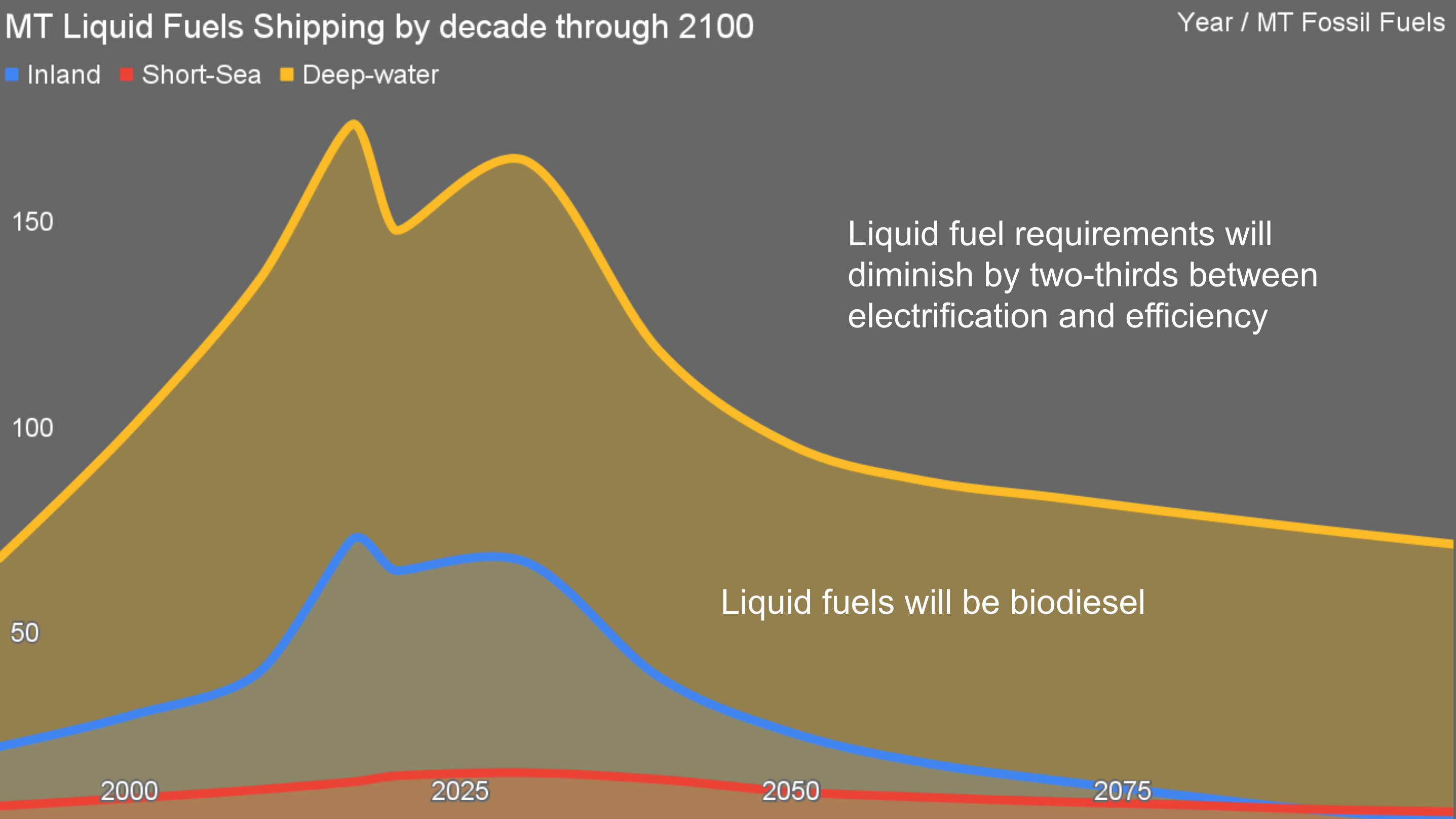
We’re already seeing a proof point on this. On the Yangtze right now, there are two 700-container ships that are battery-electric running 1,000-kilometer routes on their inland major river, and they’re doing that with containerized batteries. There’s that theme of containerization of batteries again, because they just winch the battery containers that are depleted onto shore, where somebody plugs them in, exactly as they do with refrigerated containers today, and they winch a full battery back onto the ship.
Most of these exist in the context of transshipment ports, where trains also arrive. So trains and ships will start sharing containerized batteries as an obvious mechanism for reducing emissions in both spaces. This significantly reduces our liquid fuel requirements. I’ve had discussions with the Mærsk Mc-Kinney Møller Center for Zero Carbon Shipping — far too long a name — and they are using 300 to 350 million tons of oil a year in 2050, 2100 as a requirement for maritime shipping.
My projection is only 70 million tons of maritime diesel per year.
We already manufacture 70 million tons of biodiesel annually. My projection is liquid fuels will be all biodiesel, and there won’t be nearly as many of them as we think there will be. And that, by the way, you can see the decarbonization curve there just after 2050. That’s real decarbonization, not net zero.
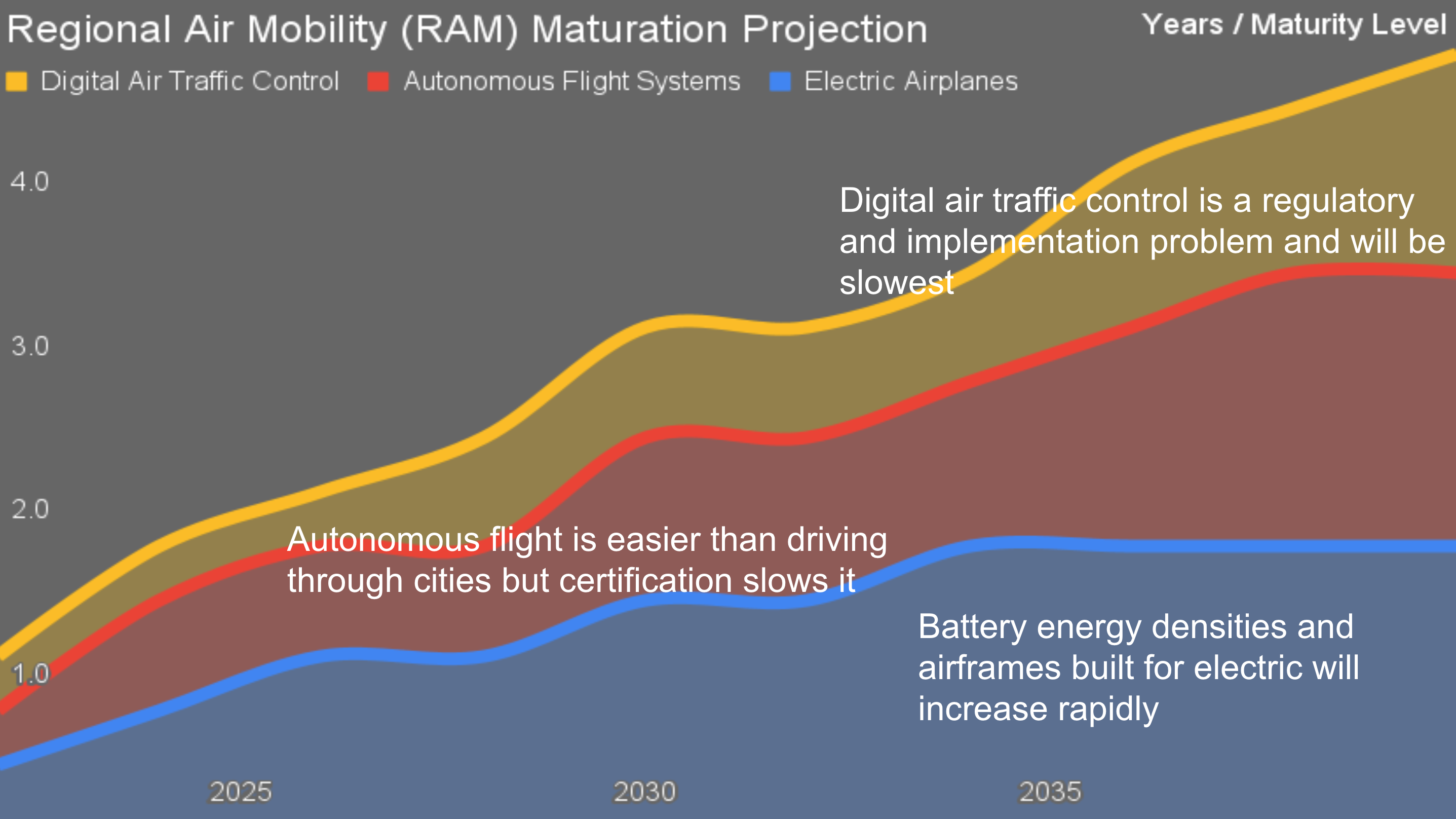
Aviation has a different pathway. Aviation, what we have is the growth of electrification of aviation. Just as ferries and other small boats are electrifying now, smaller planes will electrify first. The economics and technology are different. We don’t care nearly as much about the weight and mass of batteries in ships. We care about the weight of the batteries in aviation. We need lighter batteries with more energy density, and that’s occurring as well.
One of the things that will occur is regional air mobility. I spent time speaking with NASA people who have done the studies on regional air mobility, where the thousands of small airstrips are activated because we have small, cheap, easy to maintain, and easy to certify electric aircraft emerging to do cargo and passenger travel between neighboring small airports. Currently, aviation is dominated by hub and spoke airports with big jets.
As we move forward, we’ll need autonomous flight. We’ll need digital air traffic control, which is rapidly emerging. Everything has a transponder, and instead of English being the language of air traffic control, computer interfaces will be the language of air traffic control. Battery energy density is increasing already.
Just pulling at that battery energy density question right now with existing Tesla-scale batteries, about 250 watt-hours per kilogram and a hybrid model with biodiesel generators on a plane to provide divert and reserve energy for aviation, we can achieve about 98% decarbonization just running on electricity of aircraft with up to 100 passengers flying up to 600 km. We have that with just that energy density.
 Chip in a few dollars a month to help support independent cleantech coverage that helps to accelerate the cleantech revolution!
Chip in a few dollars a month to help support independent cleantech coverage that helps to accelerate the cleantech revolution!
Reji mentioned CATL talking about their battery energy, their battery costs going down. They’re also delivering this year a battery with double the energy density of the Tesla batteries, so that 600 km becomes 1200 kilometers. I’ve spoken to leaders of several organizations which are now building silicon anode batteries which have the potential to be double or even quintuple the energy density of CATL’s battery. There are new chemistries coming out.
The implication is that we could have 3,000-kilometer battery-only flights with hybrid generators to divert and reserve as an entirely possible viable solution before 2040. The implication is that we have a big wedge for most domestic air traffic that is emerging.
It’s much cheaper to certify an electric drivetrain because there’s only one moving part. The failure conditions are much smaller on electric drivetrains than there are current aviation drivetrains. Certification is an n times n safety concern.
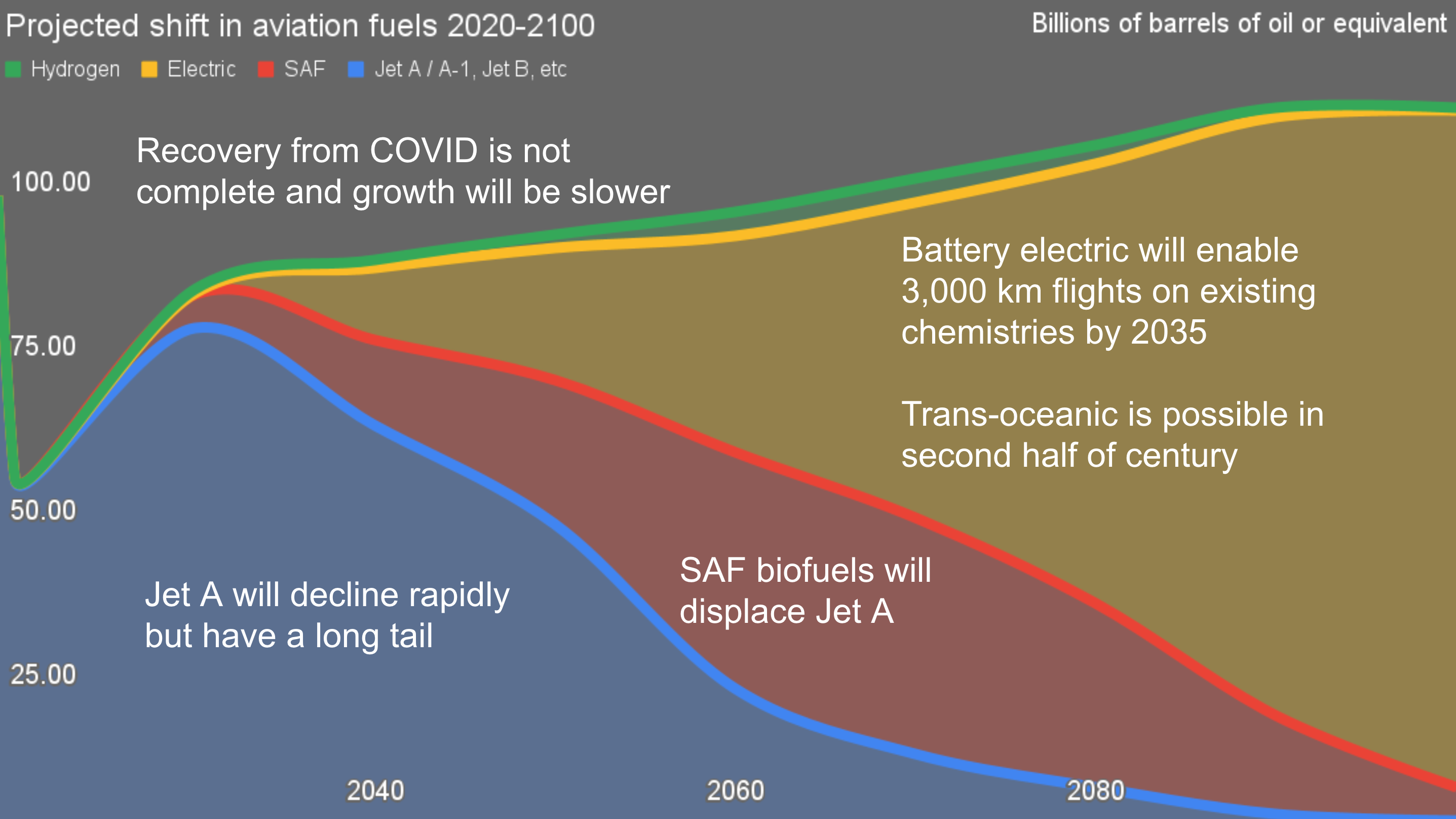
This is a projected shift of aviation through 2100, similar to the maritime one. COVID caused a significant drop, obviously, in aviation requirements. Recovery from COVID is still not complete. We’re still seeing significant pushback on some things. Smaller regional airports have not been able to find staff. The bigger hub and spokes have pilots remaining a significant problem.
A lot of flight crews got into flying in the nineties because it was great and it was fun and it was exciting. But then when COVID hit and they all had to go find something else to do. Many of them found didn’t actually love their aviation jobs, they just didn’t have a way to change.
COVID forced them to change, and now we can’t get them back. Autonomy becomes very important because flying a jet is not nearly as exciting as people make it out to be.
With 3,000 km and possibly transoceanic flights battery-electric flights in the second half of the century, Jet A declines. The burnable fuels will be, once again, biofuels. My projection by 2100, even in my battery-pessimistic model, is 110 million tons of biofuels required for aviation. With maritime shipping, that’s 180 million tons in total. We already make 100 million tons of biofuels today and we’re barely touching our biomass waste streams.
We have lots of room to grow here. This is not even a remotely difficult challenge, assuming my projection of aviation and maritime shipping demand is right.
One thing you’ll note is that the growth curve for aviation is quite slow over the coming 80 years. There are three or four reasons for that. One is we’re not going to return to the absurd period of affluence building we saw from 1980 to 2019. China has gone through that boom and it’s flattening out.
India and Indonesia and Brazil, while doing great jobs at building their economies, making themselves more affluent, don’t have the conditions for success for the double-digit growth rates that China saw, or the markets for things. India, for example, isn’t an export market economy nearly as much as China was. And Brazil is exporting dominantly resources and meat, not finished goods and manufactured goods.
So the conditions through the coming years are different. Flying for longer hauls will be more expensive because biofuels are going to be more expensive, just not as expensive as synthetic fuels.
Battery-electric, at least in the short term, will still be challenged by the capital cost of high energy density batteries. So it’s a transitional period. Higher cost of flying for the coming next 15 years will depress growth, lower economic growth and affluence than we saw in the past 40 years, but still growth.
We’ll see fewer people having the willingness to spend the additional cost for flights. I see a much lower growth rate for flying than IATA or Boeing do.
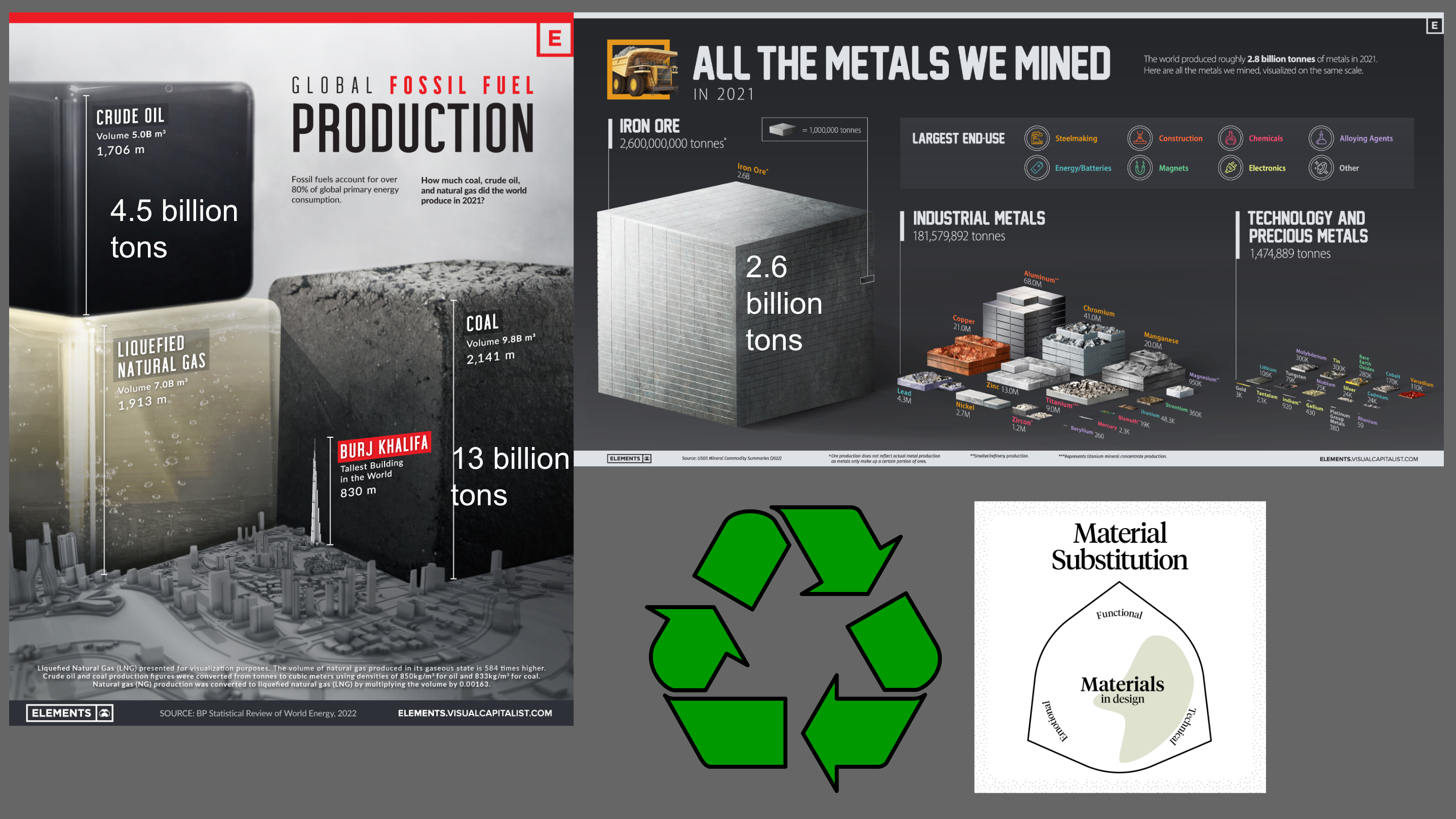
Some of this comes down to the question of minerals. Well, when we look at minerals we have on the fossil fuel side of the world, we’re doing about 20 billion tons of extraction, processing, refining, and distributing fossil fuels today almost entirely for single use, just burning them to create waste heat and carbon dioxide. Oh, and incidentally some useful working heat for us. But literally the biggest products of fossil fuels are waste heat and carbon dioxide by multiples, as carbon dioxide is two to three times the mass of the fossil fuels.
Compare and contrast that to the minerals for batteries in the minerals segment of the infographic. Industrial minerals are 180 million tons compared to 2.6 billion tons for iron ore, which won’t be going up and we’ll be scrapping a lot more. Technology and precious metals, where all the battery and most of the electrification minerals are, is only 1.5 million tons a year.
You can see that compared to 20 billion tons, all resource extraction for the minerals required for electrification is a fraction of the mineral extraction for fossil fuels.
That’s statement one. If we make battery minerals ten times bigger, it’s still a rounding error compared to the fossil fuel volumes.
Statement two is when we put 80 kg of lithium into a Tesla battery. That Tesla battery lasts for a decade and is reused over and over again. Or an electric bus, it’s reused over and over again for a decade. Once its energy capacity declines to 80% or so, it will often be repurposed for grid or behind-the-meter storage as a second life for another decade, and then we’ll mine them.
Every million tons of minerals we mine actually ends up being reused over and over and over again, and then gets recycled and turned into new mineral. Because we’re achieving greater and greater efficiencies, we actually have not perpetual, but a very, very long lifespan for any of these things, even with degradation through recycling,
We also have material substitution. Directly in your wheelhouse, we have the standard aluminum and steel wires for transmission, we have copper, but we also now have reconductoring with carbon fiber and advanced composite technologies inside transmission cables, which are lighter and less heat-challenged.
They don’t heat up as much. They don’t sag as much when they heat up. The combination means that we can actually build HVAC transmission more cheaply with modern conductors. We can also repower existing transmission with new conductors and get 30% to 50% more energy through the same transmission corridor. Subsea cables lean much more heavily on aluminum for weight purposes.
All that means is that for any metals mineral requirement, we can use other minerals with similar characteristics. We have lithium-ion batteries, but now we’re having sodium-ion batteries emerging, lithium phosphate batteries emerging. For ground solutions, we’re seeing ferrous metal ones. All this adds up.
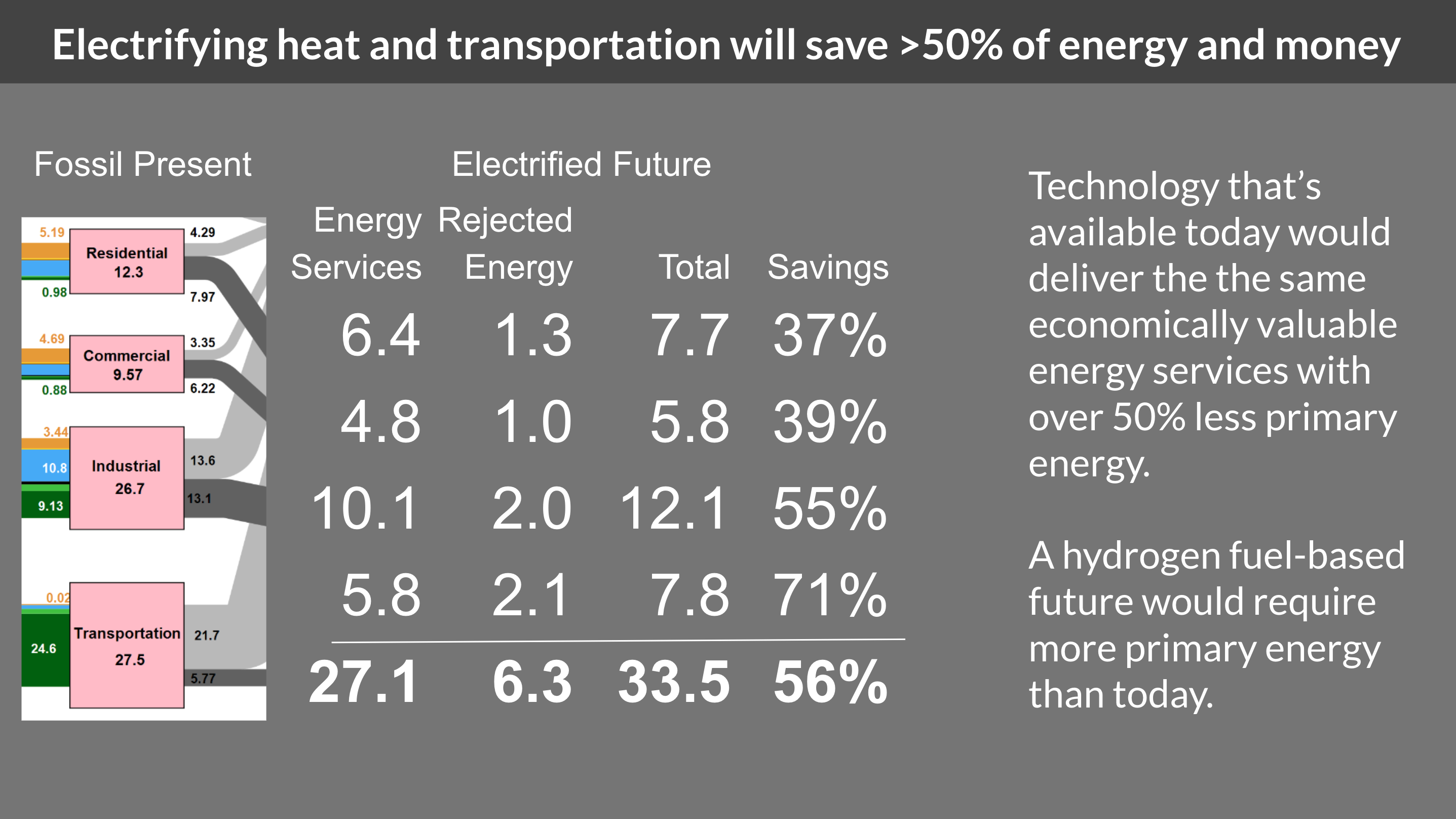
This is back to the Sankey diagram of actual energy services, the things we care about. Rejected energy plummets in an electrified solution with these wedges I’ve been describing. The United States needs 27.1 quadrillion Btu of energy. They waste 6.3. They get a total of 33.5. That’s a 56% savings of energy in an electrified world versus a fossil fuel world. That’s my calculation. It’s napkin sketch math.
Let’s look at Saul Griffith’s work. Griffith went deep and wide on this, and he created the world’s most complex and inconceivably comprehensive Sankey energy flow diagram, down to tiny fractions in his calculations, separate from mine, similar methodology, but much more robust. He got down to 42% total energy requirements versus the 100%, which means a 58% reduction in primary energy requirements.
Mark Z. Jacobson and team out of Stanford are responsible for 100% Renewables by 2050. That evolving set of material has been going since the mid two-thousands. They’ve done similar work and come up with similar numbers. Multiple people are saying exactly the same thing.
Any path which India can electrify now saves significant energy. Any path which India chooses to invest in capital infrastructure that uses fossil fuels is committing India to wasting money on a much less efficient path. Any pathway which uses hydrogen in an energy pathway, whether that’s direct use of hydrogen or as synthetic fuel, is going to increase rejected energy, not halve energy requirements for society.
The question for India is where can you leapfrog based upon existing technology? This is back to Reji’s point. Cheap batteries means you can leapfrog a lot more.

That’s my presentation. I’ve got a few minutes for questions. Reji, do you want to start sharing the questions?
Question:
Let me come to some questions. On your third or 4th, 5th or 6th slide, you had written something, all that sexy Mac slide, one of them written on complete streets. So somebody has asked, could you elaborate on that? Complete street.
Answer:
Complete streets is an urban planning concept where streets diminish the space for larger passenger vehicles a bit, they take lanes away. They create a safe corridor separated by parked cars or bollards, where bicyclists and low speed electric vehicles can move in much higher densities, but not have to worry about the safety risks of dealing with passenger transportation.
They have pedestrian spaces and they have trees lining them, so the trees provide shade for the pedestrians, cyclists, and low speed electric vehicles. We’re operating at different speeds. The cars and trucks do not have to interact with slower speed vehicles, but are in lanes which are often optimized for traffic flow.
A study out of New York with complete streets found that once a complete street had been implemented, the traffic flow for cars and trucks was slower at peak speed, but the throughput was slightly increased because they move right and left turn lanes out of the primary flow of traffic. As India’s urban areas evolve, complete streets are something to consider.
Among other things, the complete street process of putting trees in provides significant urban heat island relief and flood drainage relief.
Question:
What’s your views on bulk versus on-site generation? Primarily PV.
Answer:
One of the key things that is occurring in our energy network is that every geography that used to have to import lots of primary energy can now manufacture lots of its primary energy in the form of wind or solar. Even Singapore has lots of room for solar. It has floating solar on its reservoirs. It has rooftops for manufacturing and its HDB blocks and can get up to about 15% of its energy demand from local small photovoltaic. That’s a very big advantage. Similarly, geothermal heat sources and water heat sources are other sources of local heat or cooling. As we consider a district, it’s easier to justify drilling a geothermal source heat pump for heating or cooling for a district than it is for an individual building.
We have to think about it more in a neighborhood scale or a district scale in many cases.
For most of the world, solar photovoltaic on domestic rooftops isn’t really a huge wedge. I’ve had this discussion with Marcus Z. Jacobson simply because most of the world people live in multi-unit residential buildings, often highly dense. It’s true of New Delhi, where Reji is sitting.
These days, very few people globally live in detached homes as they do in Australia, for example. In Australia there’s a lot of single story ranch homes and they actually have more square meters per person of living space than the United States does. They have lots of room on the roofs for solar panels, Asia doesn’t.
Where I live, I have about 18 buildings over 19 stories of residential multi-unit residential buildings visible from my office window. We don’t have a lot of rooftop for solar either.
It’s always a mix. The more you can generate locally, the better, because that reduces the input. But you can generate a lot more inside a country or a region.
The energy requirements go down due to electrification. You have to import a lot less energy than many nations require at present.
Question:
For India, how can we maximize electrification of road transportation with our aging and inefficient grid?
Answer (by Reji):
Portions of our grid are aging, but we are building more. We have the newest transmission system. We have the newest distribution system. We have added a hundred million homes in the past few years. It’s just not going to be a major issue for India compared to other countries where the grid is aging and the workforce is aging. India has three advantages of a newer grid, a more stable grid, and a younger workforce, so it’s not a problem.
Addition by Michael: One of the ways to deal with an aging grid is cheap batteries. If the distribution is weak or unreliable, a simple solution is to put a battery locally, and that’s much more viable if they are cheap. Putting battery buffers in, especially for fleet vehicles like buses, is common.
Sadly the automated transcription didn’t include the remainder of the questions and answers. I suggest people interested go to the video for those. I may return to this and answer them in another article simply because questions in presentations are always so illuminating.
Have a tip for CleanTechnica? Want to advertise? Want to suggest a guest for our CleanTech Talk podcast? Contact us here.
Latest CleanTechnica.TV Video
CleanTechnica uses affiliate links. See our policy here.





